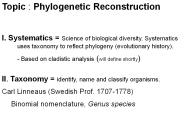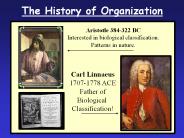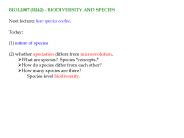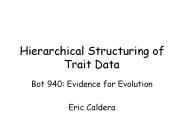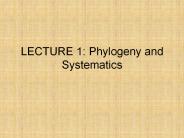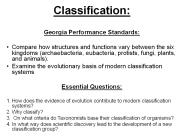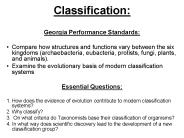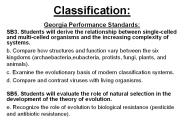Cladist PowerPoint PPT Presentations
All Time
Recommended
Only contains those monophyletic groups that are common to all competing trees ... Contains monophyletic groups that occur in a majority of the competing trees. ...
| PowerPoint PPT presentation | free to view
Liability genes = genes containing variants increasing ... Location of liability allele = (hot spot, blocky, very blocky) Draw 200 cases and 200 controls ...
| PowerPoint PPT presentation | free to view
THE ARTHROPODS. Figure 3: This cladogram shows the most parsimonious tree that was obtained ... Members of the Holt and Iudica (2006) Phylum Oomycota (Clade B) ...
| PowerPoint PPT presentation | free to view
Class Echinoidea - sea urchins & sand dollars. Class ... Archaeopteryx, a Jurassic bird-reptile. Class Mammalia - mammals. Cladistic Analysis exercise ...
| PowerPoint PPT presentation | free to download
Do they all conduct photosynthesis? All photosynthetic organisms ... Hoodia. The Cladistic method. Cladistic or phylogenteic analysis- most widely used method ...
| PowerPoint PPT presentation | free to download
Chapter 20 Classification of Living Things 20-3 * Cladistic Systematics Now that we know how to read phylogenetic trees .how are they made? Based on shared ...
| PowerPoint PPT presentation | free to download
Phylogenetic trees. Cladistic versus phenetic analyses. Model of sequence evolution ... Branch length (scaled trees only): represents the number of changes that have ...
| PowerPoint PPT presentation | free to download
BDC221 PLANT DIVERSITY (2) PLANT DIVERSITY (2) Higher plant nomenclature, identification and classification Cladistic methodology Classification systems and modern ...
| PowerPoint PPT presentation | free to view
Phenetic approach: Trees are based on some measure of distance between the leaves ... either cladistic (e.g. gene order) or phenetic ...
| PowerPoint PPT presentation | free to view
The Molecular Data and the evolutionary relationships of life's diverse forms ... A- Molecular Data led to: a- Cladistic analysis to taxonomy, b- Cladograms ...
| PowerPoint PPT presentation | free to view
Cladistics Pattern of systematics in which ... Cladistics. A true clade is a group with a single common ancestor. ... Cladistics. Other Cladistic Factors ...
| PowerPoint PPT presentation | free to view
Open-World Learning. open data and problems. open computational environment ... Create: Show how similar organisms are related using phylogenic trees (cladistic ...
| PowerPoint PPT presentation | free to view
Branches, splits, bipartitions In a rooted tree: clades Mono-, Para-, polyphyletic groups, cladists and a natural taxonomy The term cladogram refers to a strictly ...
| PowerPoint PPT presentation | free to view
Big Picture only. May use as starting point ... Birds are dinosaurs cladistic perspective. Applications Building Tree of Life ...
| PowerPoint PPT presentation | free to view
Human- 46 chromosomes Chimpanzee- 48 chromosomes Chimpanzees have 2 smaller chromosome pairs we don t have Humans have 1 larger chromosome pair (#2 ...
| PowerPoint PPT presentation | free to download
Title: Lecture #11 Date _____ Author: Chris Hilvert Last modified by: Liz Created Date: 11/15/2000 7:24:44 PM Document presentation format
| PowerPoint PPT presentation | free to view
Boundaries between units in the Geologic Time Scale are marked by dramatic biotic change ... Alligator Snapping Turtle ~ 200,000 yr ~ 20,000,000 yr ...
| PowerPoint PPT presentation | free to view
Topic : Phylogenetic Reconstruction I. Systematics = Science of biological diversity. Systematics uses taxonomy to reflect phylogeny (evolutionary history).
| PowerPoint PPT presentation | free to download
Chapter 20 Classification of Living Things
| PowerPoint PPT presentation | free to download
Phylogeny, the evolutionary history of an organism, ... There are three basic assumptions in cladistics: Organisms within a group are descended from a common ancestor.
| PowerPoint PPT presentation | free to view
Classification of Organisms Biology- Chapter 18 (508-533) Modern Bio Chapter 17 (336-351) Biology Concepts and Connections Chap 15 (304-310) Web cd 15c
| PowerPoint PPT presentation | free to download
Towards a theoretical model for the evolution of manuscript ... Too many bifurcating trees (bifid stemmata) = unrealistic. Cerquiglini, 'Eloge de la variante' ...
| PowerPoint PPT presentation | free to view
... see: Faith and Cranston 1991; Farris, 1989, Felsenstein 1985; Hillis 1991; ... Farris, J. S. (1989) 'The retention index and the rescaled consistency index. ...
| PowerPoint PPT presentation | free to download
Title: PowerPoint Presentation Author: Greg Podgorski Last modified by: Thomas Mull Created Date: 3/24/2000 9:51:25 PM Document presentation format
| PowerPoint PPT presentation | free to download
Title: Classification and Diversity Author: Preferred Customer Last modified by: Bashab Banerjee Created Date: 11/27/2006 12:44:38 AM Document presentation format
| PowerPoint PPT presentation | free to view
Crocs. Birds. 28. Phylogeny of the main vertebrate groups: ... Crocs. Birds. 29. Bootstrapping Trees 1. How much confidence do we have in any particular tree? ...
| PowerPoint PPT presentation | free to download
Tree Building What is a tree ? Cladograms Trees Scenario How to build a tree ? Observations First Principles Assumptions Methods What is a tree ? Cladograms and Trees ...
| PowerPoint PPT presentation | free to view
Title: PowerPoint Presentation Author: Jim Mallet Last modified by: jim mallet Created Date: 3/2/2004 10:27:35 AM Document presentation format: On-screen Show
| PowerPoint PPT presentation | free to download
Chapter 22 Descent with Modification: A Darwinian View of Life Evolution Evolution: the change over time of the genetic composition of ...
| PowerPoint PPT presentation | free to view
Hierarchical Structuring of Trait Data Bot 940: Evidence for Evolution Eric Caldera Scientific Method Observation and description: Organisms seem to have changed over ...
| PowerPoint PPT presentation | free to download
Chapter 8, Processes of Macroevolution Key Terms metazoa Multicellular animals; a major division of the animal kingdom. chordata The phylum of the animal kingdom that ...
| PowerPoint PPT presentation | free to download
LECTURE 1: Phylogeny and Systematics
| PowerPoint PPT presentation | free to download
Title: Phylogeny and Systematics Author: Nancy Wheat Last modified by: NANCY WHEAT Created Date: 2/11/2006 3:37:02 AM Document presentation format
| PowerPoint PPT presentation | free to download
Chapter 18: Classification 18-1 History of Taxonomy 18-2 Modern Phylogenetic Taxonomy 18-3 Two Modern Systems of Classification (F) Kingdom Animalia Multicellular ...
| PowerPoint PPT presentation | free to view
... Genus & species Leopard = Panthera pardus African Lion = Panthera leo Hierarchical classification system Taxon = a group at any level (plural,taxa ...
| PowerPoint PPT presentation | free to view
Classification: Georgia Performance Standards: Compare how structures and functions vary between the six kingdoms (archaebacteria, eubacteria, protists, fungi, plants ...
| PowerPoint PPT presentation | free to download
As wildlife biologists, it's our job to study and compile ... method of 5 furry animals using. multivariate statistics. Length of leg bone. Length of arm bone ...
| PowerPoint PPT presentation | free to view
Classification: Georgia Performance Standards: Compare how structures and functions vary between the six kingdoms (archaebacteria, eubacteria, protists, fungi, plants ...
| PowerPoint PPT presentation | free to download
What are the 6 Kingdoms of Organisms? What is a cladogram? What are the 5 ways we can determine evolutionary relationships? Archeabacteria, Eubacteria, Protists ...
| PowerPoint PPT presentation | free to download
In the 1600's, biology was changed forever by the discovery and refining of ... In the United States, we call both black vultures and turkey vultures buzzards. ...
| PowerPoint PPT presentation | free to view
Fall 05 skip acclimitization Acclimatization effects on final rectal temperature, heart rate, and sweat rate, for a group of men exposed daily to 2 hr of hard work in ...
| PowerPoint PPT presentation | free to download
BIOLOGICAL DIVERSITY: CLASSIFICATION. Taxonomy is that branch of ... apparently began the ... Birds and crocs form a _, or monophyletic group united by ...
| PowerPoint PPT presentation | free to view
Prokaryotic Cell
| PowerPoint PPT presentation | free to download
To reconstruct the phylogenetic history of taxa. To recreate the true branching pattern of evolution. To understand the evolutionary relationships between taxa ...
| PowerPoint PPT presentation | free to view
... TAXONOMIC HIERARCHY Kingdom: Animalia Phylum: Arthropoda Class: Insecta Order: Hymenoptera Family: Apidae Genus: Apis Species: mellifera Linn Ross ...
| PowerPoint PPT presentation | free to download
17.1 The History of Classification ... Diversity The most widely used biological classification system has six kingdoms ... Eukarya contains Kingdom ...
| PowerPoint PPT presentation | free to download
A brief HISTORY OF PALEONTOLOGY ... of fossils and strata Leonardo Da Vinci ... dominate work Generalizations or principles were being developed 1900 to ...
| PowerPoint PPT presentation | free to view
0 reconstructing evolutionary trees
| PowerPoint PPT presentation | free to download
Cladistics and Molecular Systematics. Depicting evolutionary changes. Homology. Homoplasy ... Characters for Cladistics. Qualitative presence / absence ...
| PowerPoint PPT presentation | free to view
CHAPTER 18 CLASSIFICATION (Taxonomy) THE SIX KINGDOMS Animalia Eukaryotic Heterotrophic Multicellular Movement Organized into tissues and organs (most animals ...
| PowerPoint PPT presentation | free to view
Organizing Life s Diversity Chapter 17 17.1 The History of Classification Early Systems of Classification Biologists use a system of classification to organize ...
| PowerPoint PPT presentation | free to download
Some scientists may think one character is important, ... Scientists must look carefully at similar traits, ... Inferring Evolutionary Relatedness, ...
| PowerPoint PPT presentation | free to view
Scientist believe there are between 5 million and 30 million species on earth. ... 2- Polyphyletic members of a taxa are derived from 2 or more ancestral forms not ...
| PowerPoint PPT presentation | free to view
Cellular Control Unit 1 Communication, Homeostasis and Energy
| PowerPoint PPT presentation | free to view
Animal Classification, Phylogeny, and Organization Chapter 7 Zoology Construct a Cladogram for Us! Gorilla Four limbs Fur No tail Tiger Four limbs Fur Tail Lizard ...
| PowerPoint PPT presentation | free to download
Classification: Georgia Performance ... (archaebacteria,eubacteria, protists, fungi, plants, and animals). ... Compare and contrast viruses with living organisms. SB5.
| PowerPoint PPT presentation | free to download


















